Analysis of distinct short and prolonged components in rebound spiking of deep cerebellar nucleus neurons
- PMID: 21039958
- PMCID: PMC3058674
- DOI: 10.1111/j.1460-9568.2010.07408.x
Analysis of distinct short and prolonged components in rebound spiking of deep cerebellar nucleus neurons
Abstract
Deep cerebellar nucleus (DCN) neurons show pronounced post-hyperpolarization rebound burst behavior, which may contribute significantly to responses to strong inhibitory inputs from cerebellar cortical Purkinje cells. Thus, rebound behavior could importantly shape the output from the cerebellum. We used whole-cell recordings in brain slices to characterize DCN rebound properties and their dependence on hyperpolarization duration and depth. We found that DCN rebounds showed distinct fast and prolonged components, with different stimulus dependence and different underlying currents. The initial depolarization leading into rebound spiking was carried by hyperpolarization-activated cyclic nucleotide-gated current, and variable expression of this current could lead to a control of rebound latency. The ensuing fast rebound burst was due to T-type calcium current, as previously described. It was highly variable between cells in strength, and could be expressed fully after short periods of hyperpolarization. In contrast, a subsequent prolonged rebound component required longer and deeper periods of hyperpolarization before it was fully established. We found using voltage-clamp and dynamic-clamp analyses that a slowly inactivating persistent sodium current fits the conductance underlying this prolonged rebound component, resulting in spike rate increases over several seconds. Overall, our results demonstrate that multiphasic DCN rebound properties could be elicited differentially by different levels of Purkinje cell activation, and thus create a rich repertoire of potential rebound dynamics in the cerebellar control of motor timing.
© 2010 The Authors. European Journal of Neuroscience © 2010 Federation of European Neuroscience Societies and Blackwell Publishing Ltd.
Figures

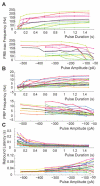

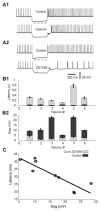
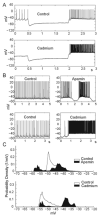
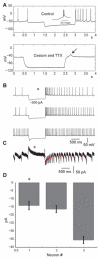
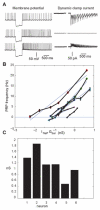
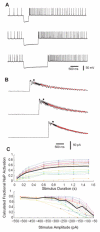
Similar articles
-
Determinants of synaptic integration and heterogeneity in rebound firing explored with data-driven models of deep cerebellar nucleus cells.J Comput Neurosci. 2011 Jun;30(3):633-58. doi: 10.1007/s10827-010-0282-z. Epub 2010 Nov 4. J Comput Neurosci. 2011. PMID: 21052805 Free PMC article.
-
Regulation of the rebound depolarization and spontaneous firing patterns of deep nuclear neurons in slices of rat cerebellum.J Neurophysiol. 1999 Oct;82(4):1697-709. doi: 10.1152/jn.1999.82.4.1697. J Neurophysiol. 1999. PMID: 10515960
-
Distinct roles for I(T) and I(H) in controlling the frequency and timing of rebound spike responses.J Physiol. 2011 Nov 15;589(Pt 22):5391-413. doi: 10.1113/jphysiol.2011.215632. Epub 2011 Oct 3. J Physiol. 2011. PMID: 21969455 Free PMC article.
-
Rebound discharge in deep cerebellar nuclear neurons in vitro.Cerebellum. 2010 Sep;9(3):352-74. doi: 10.1007/s12311-010-0168-7. Cerebellum. 2010. PMID: 20396983 Free PMC article. Review.
-
Modeling the generation of output by the cerebellar nuclei.Neural Netw. 2013 Nov;47:112-9. doi: 10.1016/j.neunet.2012.11.006. Epub 2012 Nov 21. Neural Netw. 2013. PMID: 23200193 Free PMC article. Review.
Cited by
-
Calcium-based dendritic excitability and its regulation in the deep cerebellar nuclei.J Neurophysiol. 2013 May;109(9):2282-92. doi: 10.1152/jn.00925.2012. Epub 2013 Feb 20. J Neurophysiol. 2013. PMID: 23427305 Free PMC article.
-
Synchrony and neural coding in cerebellar circuits.Front Neural Circuits. 2012 Dec 11;6:97. doi: 10.3389/fncir.2012.00097. eCollection 2012. Front Neural Circuits. 2012. PMID: 23248585 Free PMC article.
-
Determinants of rebound burst responses in rat cerebellar nuclear neurons to physiological stimuli.J Physiol. 2016 Feb 15;594(4):985-1003. doi: 10.1113/JP271894. Epub 2016 Jan 18. J Physiol. 2016. PMID: 26662168 Free PMC article.
-
Signal processing by T-type calcium channel interactions in the cerebellum.Front Cell Neurosci. 2013 Nov 27;7:230. doi: 10.3389/fncel.2013.00230. Front Cell Neurosci. 2013. PMID: 24348329 Free PMC article. Review.
-
Muscimol microinjection into cerebellar fastigial nucleus exacerbates stress-induced gastric mucosal damage in rats.Acta Pharmacol Sin. 2013 Feb;34(2):205-13. doi: 10.1038/aps.2012.152. Epub 2012 Dec 17. Acta Pharmacol Sin. 2013. PMID: 23247592 Free PMC article.
References
-
- Aizenman CD, Huang EJ, Linden DJ. Morphological correlates of intrinsic electrical excitability in neurons of the deep cerebellar nuclei. J Neurophysiol. 2003;89:1738–1747. - PubMed
-
- Aizenman CD, Linden DJ. Regulation of the rebound depolarization and spontaneous firing patterns of deep nuclear neurons in slices of rat cerebellum. J Neurophysiol. 1999;82:1697–1709. - PubMed
-
- Aizenman CD, Manis PB, Linden DJ. Polarity of long-term synaptic gain change is related to postsynaptic spike firing at a cerebellar inhibitory synapse. Neuron. 1998;21:827–835. - PubMed
Publication types
MeSH terms
Substances
Grants and funding
LinkOut - more resources
Full Text Sources
Miscellaneous

